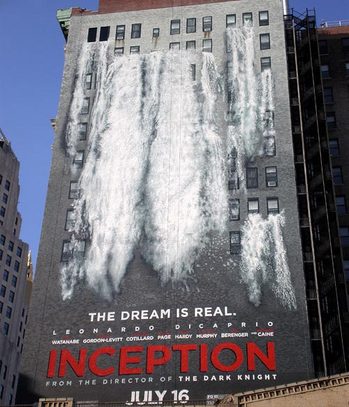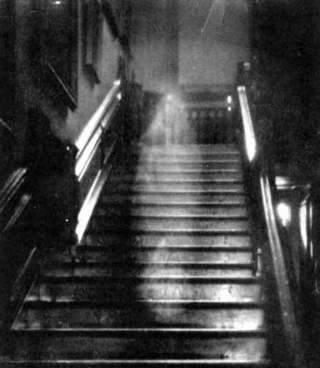 In one line: the movie “Inception” is more exciting in its conception than in its delivery. It offers some great talking-points and plenty to chew on for anyone interested in dreaming and the physics of non-ordinary reality.
In one line: the movie “Inception” is more exciting in its conception than in its delivery. It offers some great talking-points and plenty to chew on for anyone interested in dreaming and the physics of non-ordinary reality.
On the other hand, the interesting and sophisticated conceptual stuff is made to travel with a mediocre thriller plot. Whenever the film-makers are in doubt about what to do next, they insert another bang-bang shoot-em-up or car chase scene. Most of the dreamscapes are surprisingly drab and ordinary, featuring endless sterile vistas of high-rise iceboxes.
In my cinema seat, I was disappointed. Yet the movie themes linger, and can be the stuff of a good conversation about what is possible off-screen and off-world, in the real worlds of dream experience.
Let’s look at some concepts in the film that are not sci-fi at all. Shared dreaming, in which two or more people embark on conscious and intentional adventures in dream reality, is not only possible; it is a core practice in shamanic dreaming traditions and is central to my own teaching and practice. In my Active Dreaming workshops, we often have 30 or more conscious dreamers travel together on an agreed itinerary, with remarkable results. We don’t need cables, magic boxes, or potions mixed up by an alchemist in Mombasa. We used simple relaxation, clear intention, the building of a strong visual portal, and the power of steady shamanic drumming to power and focus the group journey. Needless to say, we do not used shared dreaming to invade minds!
Reality creation in the dream world, once again, is not the invention of Christopher Nolan and his crew. There are stable locales in the dreamspace, some of them more ancient than any constructions in current use on the planet, that are the product of human imaginations. I lead many group journeys to locations of this kind in what I like to call the Imaginal Realm; some of these journeys are described in my book Dreamgates. Cities, temples, palaces and residential developments in the afterlife are generated by imagination and collective beliefs. The locales in “Inception” are less alluring, the product of shackled and repetitive imaginations and of an “architect” who designs an astral trap. In Dreamgates I describe such locales as “Ibbetson lands”, after George du Maurier’s novel Peter Ibbetson, in which a prisoner meets his lover in dream locations woven from their memories.
Astral physics work differently from the rules of 3-D reality, as memorably depicted in “Inception” in scenes in which skyscrapers fold over and people walk up vertical slopes. When we explore these phenomena in Active Dreaming, we discover that on the astral plane, reality construction involves working with materials that have substance (though of much finer mesh than earthly materials) and are ideo-plastic (shaped by thought).
The different levels of dreaming depicted in “Inception” are familiar to active dreamers, as is the phenomenon of awakening from one dream into another. The most exciting first-hand account of this that I have heard from another person came from an 11-year-old girl in a class I once led for a school district. She described, in vivid detail, traveling through seven dreams, nested inside each other, and returning the same way. “Inception” manages only four.
The depiction of projections in “Inception” makes a bow to Jungian psychology. Viewers may wonder whether it is a satisfactory description of all the phenomena depicted. Cobb’s dead wife, for example, seems to be a transpersonal figure, not merely a projection.
The “militarized subconscious” of Robert Fischer, the man targeted for mind manipulation, may be fiction, but it is certainly possible – and sometimes essential – to set up psychic defense against intrusion and to call in “psychic cops”. This is another core element in my teaching and practice of Active Dreaming, and is discussed in detail in Dreamgates.
As for the key plot element in “Inception” – the effort to embed a script in someone’s mind – I wish I could dismiss this as fantasy. However, many groups throughout history have attempted mind control in this way. There is a notorious example from the ancient world. In the romance of Alexander, by pseudo-Callisthenes, an Egyptian sorcerer-king succeeds in entering and manipulating the dreaming minds of the mother of Alexander the Great and then her husband, King Philip of Macedonia.
I can readily imagine spending a long and entertaining evening discussing the pedigree and realism of the oneiric elements in “Inception.” This would be more fun than the movie itself, which became – for me – claustrophobic and tediously repetitive. The movie is unrelieved by even the tiniest spark of humor, unless an insider’s joke counts as such. (The recall signal that pulls the dream travelers back is a recording of Edith Piaf’s Je ne regrette rien as heard in the movie “La vie en rose”, starring Marion Cotillard, who plays the dead wife here.)
In the absence of humor, the thudding earnestness of “Inception” would only work if it developed much more narrative drive and the sense that something really important is at stake. But I was never made to care about why the dream gang was sent to infiltrate the mind of the heir to a business fortune.
No complaints about the acting and cinematography in “Inception”. But the great talent engaged here is confined by a lackluster
script. By the end, I was nostalgic for the verve and color and wild humor of Terry Gilliam’s version of the dreamworld in “Brazil”.
Meanwhile, I am waiting for someone in Hollywood to wake up to the fact that the real arts of Active Dreaming are not only more entertaining than this, but can be used to make things better in the world.
related articles: Shared Dreaming before and after “Inception”
Shared Dreaming as Home Entertainment
How shared dreaming saved George’s job

